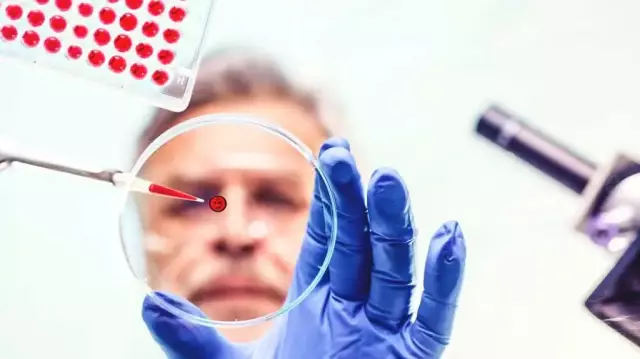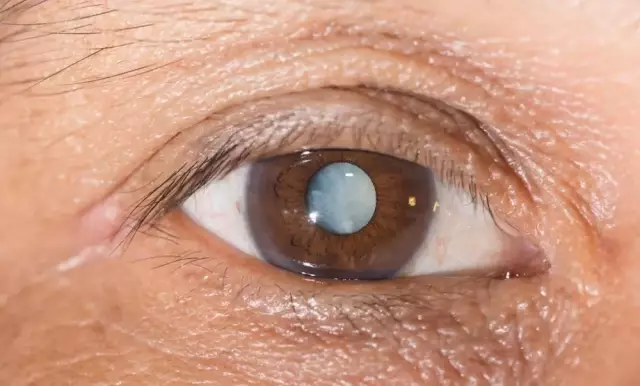- Author Rachel Wainwright [email protected].
- Public 2023-12-15 07:39.
- Last modified 2025-11-02 20:14.
Acromegaly
General characteristics of the disease

Acromegaly, or gigantism in everyday life, is a serious neuroendocrine disease. It is caused by increased secretion of the hormone growth hormone, the so-called growth hormone.
Gigantism is commonly referred to as acromegaly in pediatric and adolescent patients. The increased production of growth hormone in them leads to excessive linear growth. In adult patients, acromegaly is characterized by overgrowth of soft tissues and periosteum, as well as excessive weight gain.
In 99% of cases, acromegaly develops as a result of a pituitary adenoma. With acromegaly, there is a pathological increase in all internal organs of a person: heart, lungs, spleen, liver, intestines and pancreas. Their hypertrophy is fraught with hardening of tissues and the development of multiple organ failure. In addition, a patient with acromegaly symptoms has an increased likelihood of benign and malignant tumors.
Acromegaly occurs on average in 50 out of 1 million people. The gender of the patient does not matter. Most often, pituitary adenoma and acromegaly, as a result, are diagnosed in people 40-60 years old.
Causes of acromegaly
The predominant number of cases of diagnosed acromegaly occurs as a result of pure somatotropic adenoma (aka somatotropinoma). Acromegaly can also be combined. The cause of this type of adenoma is the excessive secretion of growth hormone and prolactin or growth hormone and other types of adenohypophyseal hormones.
So among the causes of acromegaly are pathologies of hormone secretion:
- TSH (thyroid stimulating hormone),
- LH (luteinizing hormone or luteotropin),
- FSH (follicle stimulating hormone),
- a-subunits, etc.
In most cases, acromegaly is caused by mutations in somatotrophs. This is the name of a special type of pituitary secretory granule.
Acromegaly can also develop as a consequence of MEN-1 syndrome (multiple endocrine neoplasia). This disease of hereditary etiology is characterized by the formation of numerous tumors in the pituitary gland, thyroid and thymus glands, adrenal glands, nervous system and gastrointestinal tract.
Acromegaly symptoms
Symptoms of acromegaly have a slow rate of increase. On average, in adulthood, the disease is diagnosed only 10 years after the manifestation of the first symptoms of acromegaly.
The main symptoms of acromegaly include changes in appearance. It is thanks to them - the coarsening of facial features, an increase in the cheekbones, eyebrows, and the lower jaw - that a person may suspect that he has a disease.
The soft tissues of a patient with acromegaly symptoms are hypertrophied: the tongue, ears, nose, lips, hands and feet are slightly enlarged. In the course of further progression of the disease, the bite changes due to the growth of interdental spaces.

In pediatric and adolescent patients, the main symptom of acromegaly is an excessive linear growth rate, outstripping all age norms.
Additional symptoms of acromegaly include:
- arthralgia (excessive formation of cartilage tissue),
- increased sweating and excessive activity of the sebaceous glands,
- thickening of the upper layer of the skin,
- splanchnomegaly (enlarged spleen)
- degeneration of muscle fibers, causing a decrease in performance and physical inactivity.
Chronic overproduction of growth hormone in acromegaly can lead to multiple organ failure. Symptoms of late stage acromegaly are myocardial hypertrophy, heart failure, and increased intracranial pressure.
In 90% of patients with acromegaly symptoms, apnea syndrome is diagnosed - the threat of respiratory arrest during sleep, caused by the proliferation of airway tissues.
Acromegaly is also a cause of erectile dysfunction in men and menstrual irregularities in women of childbearing age.
Diagnosis of acromegaly
Acromegaly is diagnosed on the basis of blood test data for the level of IRF-1 (somatomedin C). Under normal conditions, a provocative glucose load test is recommended. For this, a patient with suspected acromegaly is sampled blood every 30 minutes 4 times a day.
To visualize the cause of acromegaly - a pituitary adenoma, an MRI of the brain is performed. In the diagnosis of the disease, it is also important to exclude possible complications of acromegaly: diabetes mellitus, intestinal polyposis, heart failure, goiter, etc.
Acromegaly treatment
The main goal of acromegaly treatment is to normalize the production of growth hormone. For this, the patient undergoes surgical removal of the pituitary adenoma. Surgical treatment of acromegaly, provoked by small tumors, in 85% of cases leads to normal secretion of hormones and to stable remission. Surgical treatment of acromegaly caused by a large pituitary tumor is effective in only one third of cases.

In the conservative treatment of acromegaly, somatotropin antagonists are used - artificial analogs of the somatostatin hormone: Lanreotide and Octreotide. Thanks to their regular use in 50% of patients, it is possible to normalize the level of hormones, as well as cause a decrease in the size of the pituitary tumor.
It is also possible to reduce the synthesis of growth hormone by taking somatotroph receptor blockers, for example, Pegvisomantom. This method of treating acromegaly still needs further study.
Radiation treatment of acromegaly is considered ineffective as an independent method of therapy and can only be used as part of comprehensive measures to combat the disease.
YouTube video related to the article:
The information is generalized and provided for informational purposes only. At the first sign of illness, see your doctor. Self-medication is hazardous to health!






